以下操作在Hadoop分布式集群基础上进行。 一。分布式环境搭建 下载:http://www.apache.org/dyn/closer.cgi/hbase/,hbase-0.98.0-had
以下操作在Hadoop分布式集群基础上进行。
一。分布式环境搭建
下载:http://www.apache.org/dyn/closer.cgi/hbase/ ,hbase-0.98.0-hadoop2-bin.tar.gz。
1.在master主控机安装HBase
1)解压
SHELL$ tar -zxvf hbase-0.98.0-hadoop2-bin.tar.gz
SHELL$ mv hbase-0.98.0-hadoop2 ~/hbase0.98.0hadoop2
2)配置环境变量
(1)修改/etc/profile文件
SHELL$ sudo gedit /etc/profile

(2)验证

3)修改%HBASE%/conf/hbase-env.sh
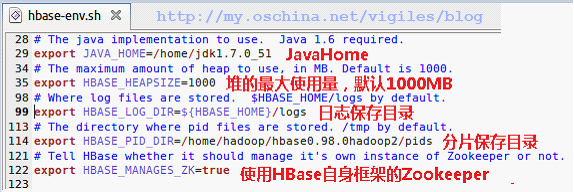
4)修改$HBASE_HOME/conf/hbase-site.xml
<?xml version="1.0"?><?xml-stylesheet type="text/xsl" href="configuration.xsl"?><configuration> <property> <!-- hbase的master主机名和端口 --> <name>hbase.master</name> <value>hdfs://192.168.1.240:60000</value> </property> <property> <!-- Hbase数据保存目录 --> <name>hbase.rootdir</name> <!-- 主机和端口号与$HADOOP_HOME/.../core-site.xml的fs.defaultFS的主机和端口号一致 --> <value>hdfs://192.168.1.240:9000/hbase</value> </property> <property> <!-- 开启分布式 --> <name>hbase.cluster.distributed</name> <value>true</value> </property> <property> <!-- hbase集群中zookeeper的主机各节点,使用奇数可尽量确保选举leader公平 --> <name>hbase.zookeeper.quorum</name> <!-- value>hapsalve1,hapsalve2,hapsalve3</value --> <value>192.168.1.241,192.168.1.242,192.168.1.243</value> </property> <property> <!-- hbase临时文件位置 --> <name>hbase.tmp.dir</name> <value>/home/hadoop/hbase0.98.0hadoop2/hbase-tmp</value> </property> <property> <!-- hbase临时zookeeper数据存放位置 --> <name>hbase.zookeeper.property.dataDir</name> <value>/home/hadoop/hbase0.98.0hadoop2/zookeeper-temp</value> </property></configuration>
5)$HBASE_HOME/conf/regionservers 文件增加

2.把HBase复制到slave从属机
SHELL$ sudo scp -rpv /home/hadoop/hbase0.98.0hadoop2/ hadoop@hapslave*:/home/hadoop/
3.启动HBase集群
在Hadoop集群启动后,再启动HBase集群。
SHELL$ start-hbase.sh

在主控机通过web界面查看(本例配置4个节点):

4.停止HBase集群
SHELL$ stop-hbase.sh
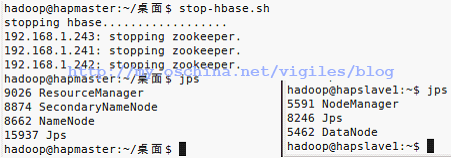
二。HBase Shell
SHELL$ hbase shell

1.建表create
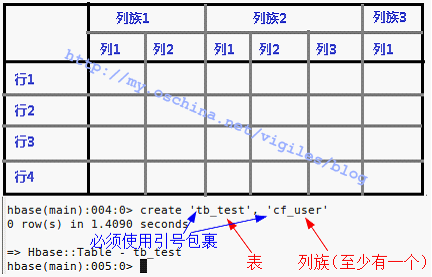
2.列出全部表list

3.表描述describe

4.删除表disable,drop

5.插入条目put
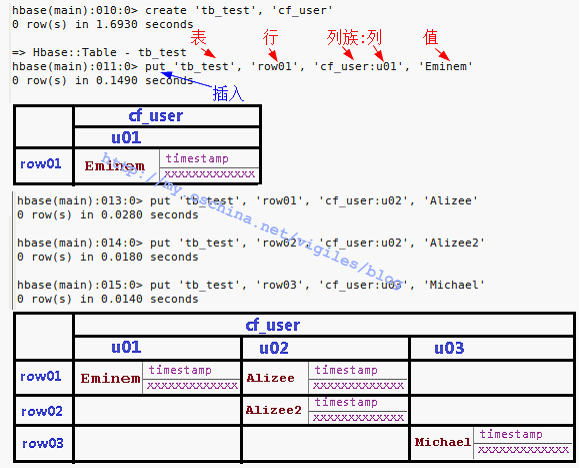
6.展示全表scan
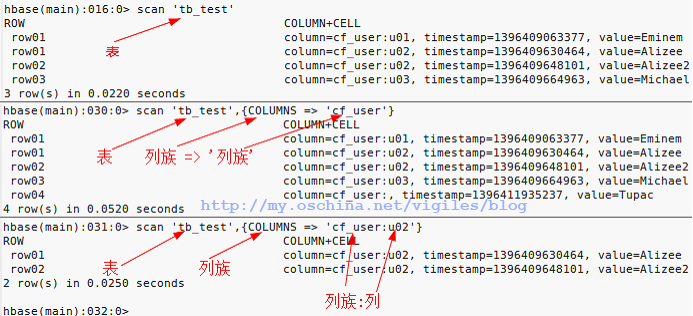
7.查询条目get
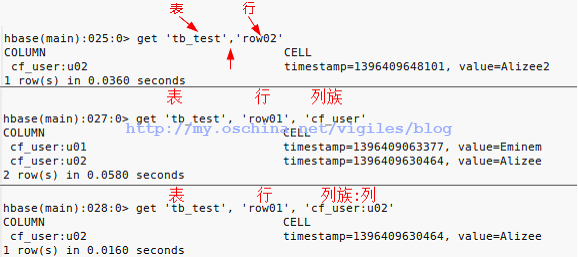
8.更新条目put

9.删除条目delete

清空表:
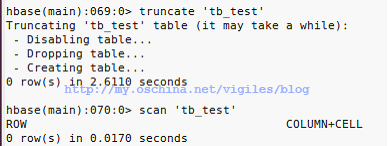
truncate是一个能够快速清空资料表内所有资料的SQL语法。并且能针对具有自动递增值的字段,做计数重置归零重新计算的作用
10.统计参数

三。JavaAPI
全部API在%HBase%/docs目录里,完全是英文的。
本例所须全部jar都可以在%HBase安装目录%/lib目录中找到。图省事,我一股脑儿全导入了。

1.创建一张表
package com.cuiweiyou.test;import java.io.IOException;import java.util.Iterator;import java.util.List;import org.apache.hadoop.conf.Configuration;import org.apache.hadoop.hbase.Cell;import org.apache.hadoop.hbase.CellUtil;import org.apache.hadoop.hbase.HBaseConfiguration;import org.apache.hadoop.hbase.HColumnDescriptor;import org.apache.hadoop.hbase.HTableDescriptor;import org.apache.hadoop.hbase.TableName;import org.apache.hadoop.hbase.client.Delete;import org.apache.hadoop.hbase.client.Get;import org.apache.hadoop.hbase.client.HBaseAdmin;import org.apache.hadoop.hbase.client.HTable;import org.apache.hadoop.hbase.client.Put;import org.apache.hadoop.hbase.client.Result;import org.apache.hadoop.hbase.client.ResultScanner;import org.apache.hadoop.hbase.client.Scan;import org.apache.hadoop.hbase.util.Bytes;import org.junit.Test;public class HBaseTest { //创建表 @Test public void creatTable() throws Exception { String strTBName = "tb_test"; //表 String strColFamily = "cf"; //列族 //配置 Configuration conf = HBaseConfiguration.create(); conf.set("hbase.zookeeper.quorum", "192.168.1.241,192.168.1.242,192.168.1.243"); //管理员 HBaseAdmin hbaseAdmin = new HBaseAdmin(conf); //addColumn(String tableName, HColumnDescriptor column) //向一个已经存在的表添加咧 //checkHBaseAvailable(HBaseConfiguration hbaseConf) //静态函数,查看HBase是否处于运行状态 //deleteTable(byte[] tableName) //删除一个已经存在的表 //enableTable(byte[] tableName) //使表处于有效状态 //disableTable(byte[] tableName) //使表处于无效状态 //HTableDescriptor[] listTables() //列出所有用户控件表项 //modifyTable(byte[] tableName, HTableDescriptor tableDesc) //修改表的模式,是异步的操作,耗时 //tableExists(String tableName) //检查表是否存在 //表名称 TableName tableName = TableName.valueOf(strTBName); //表描述器 HTableDescriptor tableDesc = new HTableDescriptor(tableName); //removeFamily(byte[] column) //移除一个列族 //getName() //获取表的名字 //getValue(byte[] key) //获取属性的值 //setValue(String key, String value) //设置属性的值 tableDesc.addFamily(new HColumnDescriptor(strColFamily));//添加列族 //创建一个表,同步操作 hbaseAdmin.createTable(tableDesc); System.out.println("创建表" + strTBName + "成功"); }} 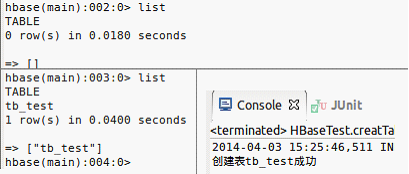
2.添加一条记录
//为表添加数据 @Test public void addData() throws IOException { String strTBName = "tb_test"; String strColFamily = "cf"; String strColumn = "col"; //列名 String strRowKey = "row1"; //行号 String strValue = "values"; //值 Configuration conf = HBaseConfiguration.create(); conf.set("hbase.zookeeper.quorum", "192.168.1.241,192.168.1.242,192.168.1.243"); //表实例 HTable table = new HTable(conf, strTBName); //close() 释放所有的资源或挂起内部缓冲区中的更新 //exists(Get get) 检查Get实例所指定的值是否存在于HTable的列中 //get(Get get) 获取指定行的某些单元格所对应的值 //getEndKeys() 获取当前一打开的表每个区域的结束键值 //getScanner(byte[] family) 获取当前给定列族的scanner实例 //getTableDescriptor() 获取当前表的HTableDescriptor实例 //getTableName() 获取表名 //isTableEnabled(HBaseConfiguration conf, String tableName) 检查表是否有效 // 获取所有的列族 HColumnDescriptor[] columnFamilies = table.getTableDescriptor().getColumnFamilies(); //HColumnDescriptor的常用方法: //getName() //获取列族的名字 //getValue(byte[] key) //获取对应的属性的值 //setValue(String key, String value) //设置对应属性的值 //插入器 Put put = new Put(Bytes.toBytes(strRowKey));// 设置行号,RowKey //add(byte[] family, byte[] qualifier, byte[] value) 将指定的列和对应的值添加到Put实例中 //add(byte[] family, byte[] qualifier, long ts, byte[] value) 将指定的列和对应的值及时间戳添加到Put实例中 //getRow() 获取Put实例的行 //getRowLock() 获取Put实例的行锁 //getTimeStamp() 获取Put实例的时间戳 //isEmpty() 检查familyMap是否为空 //setTimeStamp(long timeStamp) 设置Put实例的时间戳 for (int i = 0; i < columnFamilies.length; i++) { String familyName = columnFamilies[i].getNameAsString(); // 获取列族名 //指定列族 if (familyName.equals(strColFamily)) { //插入 put.add(Bytes.toBytes(familyName), Bytes.toBytes(strColumn), Bytes.toBytes(strValue)); } } table.put(put); //运行插入器 System.out.println("存入数据完毕"); } 
3.读取指定行记录
//根据RowKey查询整行 @Test public void getRow() throws IOException { String strTBName = "tb_test"; String strRowKey = "row1"; Configuration conf = HBaseConfiguration.create(); conf.set("hbase.zookeeper.quorum", "192.168.1.241,192.168.1.242,192.168.1.243"); HTable table = new HTable(conf, strTBName); //获取表实例 //查询器 Get get = new Get(Bytes.toBytes(strRowKey)); //查询指定行 //addColumn(byte[] family, byte[] qualifier) 获取指定列族和列修饰符对应的列 //addFamily(byte[] family) 通过指定的列族获取其对应列的所有列 //setTimeRange(long minStamp,long maxStamp) 获取指定取件的列的版本号 //setFilter(Filter filter) 当执行Get操作时设置服务器端的过滤器 Result result = table.get(get); //containsColumn(byte[] family, byte[] qualifier) 检查指定的列是否存在 //getFamilyMap(byte[] family) 获取对应列族所包含的修饰符与值的键值对 //getValue(byte[] family, byte[] qualifier) 获取对应列的最新值 List<Cell> listCells = result.listCells(); //指定行、全部列族的全部列 for (Cell cell : listCells) { System.out.println("列 族:" + Bytes.toString(CellUtil.cloneFamily(cell))); System.out.println("列 名:" + Bytes.toString(CellUtil.cloneQualifier(cell))); System.out.println("列 值:" + Bytes.toString(CellUtil.cloneValue(cell))); System.out.println("时间戳:" + cell.getTimestamp()); } } 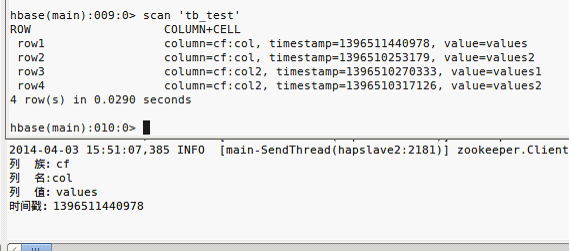
4.显示所有数据
//遍历全部条目 @Test public void getAllRows() throws IOException { String strTBName = "tb_test"; Configuration conf = HBaseConfiguration.create(); conf.set("hbase.zookeeper.quorum", "192.168.1.241,192.168.1.242,192.168.1.243"); HTable table = new HTable(conf, strTBName); //获取表实例 //扫描器 ResultScanner resultScanner = table.getScanner(new Scan()); //针对全表的查询器 Iterator<Result> results = resultScanner.iterator(); while(results.hasNext()) { Result result = results.next(); List<Cell> cells = result.listCells(); for(Cell cell : cells) { System.out.println("列 族:" + Bytes.toString(CellUtil.cloneFamily(cell))); System.out.println("列 名:" + Bytes.toString(CellUtil.cloneQualifier(cell))); System.out.println("列 值:" + Bytes.toString(CellUtil.cloneValue(cell))); System.out.println("时间戳:" + cell.getTimestamp() + "/n------------------"); } } } 
5.更新条目
//更新表中某行的某一列 @Test public void updateTable() throws IOException { String strTBName = "tb_test"; String strColFamily = "cf"; String strColumn = "col"; String strRowKey = "row1"; String strNewValue = "NewValues"; Configuration conf = HBaseConfiguration.create(); conf.set("hbase.zookeeper.quorum", "192.168.1.241,192.168.1.242,192.168.1.243"); HTable table = new HTable(conf, strTBName); //获取表实例 Put put = new Put(Bytes.toBytes(strRowKey)); //仍然是插入操作(已知列族,已知列,新值) put.add(Bytes.toBytes(strColFamily), Bytes.toBytes(strColumn), Bytes.toBytes(strNewValue)); table.put(put); System.out.println("更新结束"); } 
6.删除单元格
//删除指定行的指定的列(删除单元格) @Test public void deleteColumn() throws IOException { String strTBName = "tb_test"; String strColFamily = "cf"; String strColumn = "col"; String strRowKey = "row1"; Configuration conf = HBaseConfiguration.create(); conf.set("hbase.zookeeper.quorum", "192.168.1.241,192.168.1.242,192.168.1.243"); HTable table = new HTable(conf, strTBName); //获取表实例 //删除器 Delete del = new Delete(Bytes.toBytes(strRowKey)); del.deleteColumns(Bytes.toBytes(strColFamily), Bytes.toBytes(strColumn)); table.delete(del); System.out.println("行:" + strRowKey + ",列族:"+ strColFamily +",列:"+ strColumn +",删除完毕"); } 
7.删除整行
//删除整行 @Test public void deleteAllColumn() throws IOException { String strTBName = "tb_test"; String strRowKey = "row1"; Configuration conf = HBaseConfiguration.create(); conf.set("hbase.zookeeper.quorum", "192.168.1.241,192.168.1.242,192.168.1.243"); HTable table = new HTable(conf, strTBName); //获取表实例 Delete deleteAll = new Delete(Bytes.toBytes(strRowKey)); table.delete(deleteAll); System.out.println("这一行全删除了"); } 
8.删除表单
//删除表 @Test public void deleteTable() throws IOException { String strTBName = "tb_test"; Configuration conf = HBaseConfiguration.create(); conf.set("hbase.zookeeper.quorum", "192.168.1.241,192.168.1.242,192.168.1.243"); HBaseAdmin admin = new HBaseAdmin(conf); admin.disableTable(strTBName); admin.deleteTable(strTBName); System.out.println(strTBName + "表 删除了"); } 
- end
欢迎加入Hadoop技术交流及就业指导群:199362441




